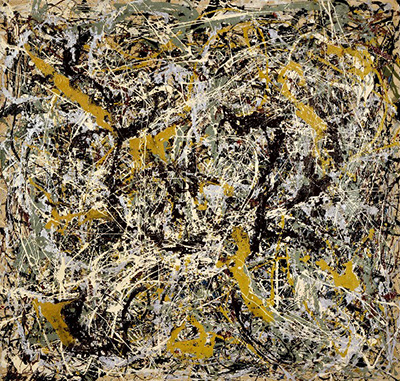Number 11 or Blue Poles (1952), is possibly one of Jackson Pollock’s most recognized art works.
Featuring embedded shards of glass, footprints and enamel and aluminum paint poured and dripped onto the canvas, this painting was originally known as Blue Poles.
However, during this turbulent and alcohol-fuelled period in Pollock’s life, he began to use numbers to identify and name his works.
He believed that people should appreciate a picture for what it is – a pure painting. Pollock felt that giving a painting a name or title attached a personality or characterisation to the artwork, whereas numbers were neutral.
During this period in Jackson Pollock’s life, he was drinking heavily and many believe the Number 11 painting was spontaneous outburst of drunken rage. This however, is untrue: it was gradually created and constructed over a period of time.
Many critics argue that Pollock deliberately designed the blue lines to represent distinctive figures or objects (for example they are interpreted as being totem poles or swaying masts of tall ships).
However, it is possible that these blue lines unite the large picture by joining the separate sections of the painting and the different artistic configurations together.
Entitled Number 11, it was unveiled in New York on the 10th November 1952, at the Jackson Pollock exhibition at Sidney Janis Gallery. This continued his decision to use numbers and the year of creation to replace conventional descriptive titles (which first started at his 1949 exhibition at the Betty Parsons Gallery).
Many people incorrectly think that the Number 11 painting by Jackson Pollock was first revealed in 1953. The cause of this confusion can be traced back to the inscription in the bottom-left hand corner of the painting.
Initially Pollock dated Number 11 as ‘1953’ before changing the 3 to a 2. However, this correction can be validated and sources back up the date as being 1952: Number 11 was exhibited at the Sidney Janis Gallery in late 1952.
A photograph of Number 11 was also printed in the December 1952 edition of Artnews, with a review written by Robert Goodnough.




